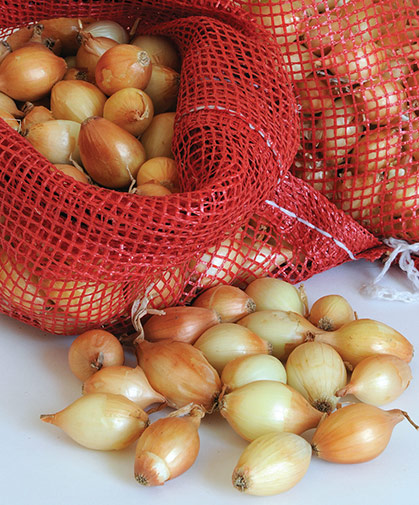Onion Sets - Key Growing Information

SCIENTIFIC NAME:
Allium cepaCULTURE:
Onion sets should be planted as soon as possible — ideally within one week of receiving them. If you cannot plant immediately, store in a cool, dry, and dark place with good ventilation. Onions require a fertile, well-drained soil with a pH of 6.2-6.8. Sandy loam soils are ideal, so raised beds or raised rows are recommended for heavier soils to promote soil drainage. Full sun is required for optimal growth. Onions require frequent irrigation during the growing season and the equivalent of 1" of water per week. PLANTING:
Plant approximately 1" deep with the base of the bulb (the rounded root-end portion of the bulb) facing down, 4" apart in rows 12-18" apart. If you would like to harvest some of the crop during the growing season as green or fresh onions, space plants closer in-row and harvest every other onion as needed. For spring plantings, plant as soon as the soil can be worked. For fall plantings, plant around the same time you would garlic, before the ground freezes (we plant mid-October through late November in hardiness zone 5a). Irrigate as necessary until the ground freezes. We recommend growing in a low tunnel; cover with row cover once temperatures are consistently dropping below 25°F (-4°C) and add a layer of greenhouse plastic before winter low temperatures set in. Vent the tunnel in spring to avoid excessive heat and remove the covering entirely once the threat of snow has passed and high temperatures are consistently above 25°F (-4°C).DISEASES, INSECTS AND WEEDS:
Adequate air circulation will aid in reducing the risk of foliar disease, as do crop rotation and good sanitation—remove all culls and crop debris each season. Thrips are the most common Allium crop pest, but ‘Forum' onions have shown resistance in our trials. Reduce thrips' overwintering habitat by keeping fields free of weeds and crop debris. Combat serious thrips infestations with insecticides such as spinosad, pyrethrin, or insecticidal soap (see our Insect Control Chart). Overhead irrigation can also help knock thrips down off leaves (however, overhead irrigation can also increase the risk of foliar disease). Controlling weeds is also critical to the success of your onion crop. Competition from weeds will reduce yields and encourage insect pest populations. Cultivate carefully so as not to damage the base of the plants and shallow root systems. An application of organic mulch will also help control weeds and preserve moisture. All Johnny's onion sets are tested and certified free from the presence of white rot and parasitic nematodes.HARVEST: For bunching green onions, harvest once small bulbs have developed. For full-size onions, necks will become soft and tops will begin to fall over when mature. At this point, watering should be discontinued. When approximately 50% of the tops have fallen over, pull the onions out of the ground and let dry in the sun for 2-7 days. When foliage and necks are completely dry, clip roots and cut back tops to 1". 'Forum' is not a long-storage onion, but if properly cured will store for approximately 3 months.


